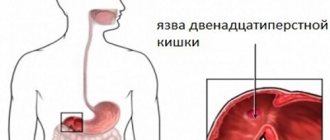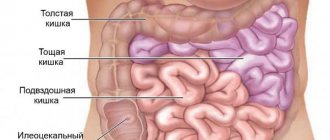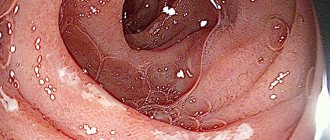Intestinal dyskinesia is a functional disease (this means that there is no pathology) characterized by impaired intestinal motor function.
Intestinal dyskinesia can act as a primary or secondary disorder:
- Primary dyskinesia - the disease occurs independently, all other disorders arise against its background;
- Secondary dyskinesia - there is an underlying disease (for example, within an organ system, there may be a chronic disease), and against the background of this disease a functional disorder of the intestine develops.
Causes
- The background for the development of intestinal dyskinesia is a hormonal imbalance;
- There are also functional reasons - disruption of the endocrine system and gastrointestinal system;
- And the development of this functional disease is also significantly influenced by disorders within the central nervous system (CNS) and the autonomic nervous system (ANS).
Risk factor
Another disease may be a risk factor : mental disorder, neurosis (not a disorder), chronic gastrointestinal diseases
(gastrointestinal tract), chronic disorders in the endocrine system of the body. Heredity can also play a significant role.
Intestinal dyskinesia is extremely common among the world's population. Almost a third of the world's population suffered from this disorder. Women are more susceptible to this disease than men.
Treatment
Therapeutic measures for any type of dyskinesia are pathogenetic and symptomatic in nature.
Hypomotor type
Drugs
- Laxatives (Duphalac, Guttalax, etc.). Drugs in this group, by attracting water into the intestinal lumen, thin the stool and promote better bowel movements.
- Prokinetics (Motilium, etc.). Drugs in this group normalize the evacuation-motor function of the intestine, enhance peristalsis, and accelerate the passage of food through the digestive tract.
- Antispasmodics (No-spa, etc.), reducing spasm in smooth muscle cells, relieve pain.
- Enzymes (Creon, Mezim, etc.) improve digestion processes and reduce the load on the gastrointestinal tract.
- Probiotics (Acipol, Bifidumbacterin, etc.) normalize the intestinal microflora.
- Antidepressants for signs of depression and neuroses.
Be sure to read:
Causes of abdominal pain: pathological and non-pathological cases
Diet
There is no special diet. The volume of fluid consumed increases. The diet includes foods that promote bowel movement:
- dairy products;
- black bread;
- fruits;
- mineral water;
- millet;
- buckwheat;
- oatmeal.
Exercise therapy
Increasing physical activity has a beneficial effect on preventing constipation. The exercises are aimed at strengthening the anterior abdominal wall (rolling on the stomach on large balls). For spastic constipation, it is recommended to use slow, gentle exercise and swimming. For atonic constipation, intense, strength training.
Abdominal massage
Vigorous abdominal massage techniques are used to stimulate intestinal motility.
Physiotherapy
Electrophoresis with calcium is used on the abdominal area, DDT, SMT.
Hypermotor type
Drugs
- Antidiarrheals (Imodium, etc.) reduce the manifestations of diarrhea until the symptom is completely relieved.
- Enterosorbents (Smecta, etc.) are used as an aid in the fight against diarrhea and flatulence.
- Antispasmodics (Buscopan, etc.) are prescribed in the presence of pain.
- Carminatives (Espumizan) help with flatulence and bloating.
- Enzymes (Microzyme, etc.) improve digestion processes.
- Antidepressants are prescribed for signs of a neurotic disorder, which may be the cause of dyskinesia.
Diet
The diet includes foods that can slow down intestinal motility:
- Black tea;
- cocoa;
- semolina;
- rice;
- jelly;
- slimy soups.
Exercise therapy
The exercises involve gentle strength, no intensity. Running, jumping, and squats are not recommended. Swimming and segmental massage help well in the fight against hypermotor dyskinesia.
Physiotherapy
Electrophoresis with novocaine, no-shpa or platyphylline is used to reduce pain. You can use SMT, paraffin baths, inductoremia in combination with therapeutic mud, IRT. Physiotherapy is aimed at reducing the tone of the intestinal walls, relaxing smooth muscle cells and reducing pain.
In continuation of the topic, be sure to read:
- Causes of bloating and increased gas formation, treatment methods
- Rectal fissure: causes, symptoms and treatment of pathology
- Details about the coprogram: preparation, conduct and interpretation of the analysis
- More about hemorrhoids: causes, symptoms and treatment methods
- Details about bowel cancer: stages, symptoms, treatment and prognosis
- Why does pain occur during bowel movements and how to diagnose the cause?
- Rectal cancer: symptoms, stages, treatment and prognosis for life
- Intestinal disorder and methods of its treatment: diet and medications
- Sigmoiditis (inflammation of the sigmoid colon): symptoms and treatment methods
- Intestinal tumors: types, symptoms, treatment methods and prognosis for life
Symptoms of the disorder
At night, the disease almost never manifests itself, and sleep is not disturbed. Symptoms are felt after eating.
Painful sensations
Characteristic:
- stabbing pain;
- cutting;
- stupid.
Localization of pain:
- around the navel (most often);
- below the navel (rare).
Duration and intensity of pain:
- paroxysmal;
- constant.
When pain decreases or disappears:
- after performing an act of defecation;
- after the gases have passed.
Main complaints:
- pain (becomes stronger in the evening);
- feeling of fullness in the intestines;
- constipation;
- flatulence;
- nausea;
- belching;
- increased amount of fluid in stool;
- the act of defecation is often difficult, but the urge is frequent - at least three times a day;
- rumbling in the stomach.
Many people suffering from intestinal dyskinesia often experience neuroses.
Types of intestinal dyskinesia
In the case of spastic ( hypermotor ) intestinal dyskinesia, increased intestinal tone and spastic contractions are observed. The consequence of this condition can be constipation, as well as colic in the abdomen. If a patient has atonic ( hypomotor ) dyskinesia, then there is a sharp weakening of intestinal tone and motility. The consequence of this will be constipation, dull pain, a feeling of fullness, and in some cases intestinal obstruction . In turn, the consequence of constipation will be the accumulation of feces in the intestines, which leads to dizziness , weakness, nausea, and decreased performance. The contents of the intestines undergo rotting, and this can provoke an allergic reaction. Chronic constipation can cause hemorrhoids and anal fissures .
There are also primary intestinal dyskinesia, in which intestinal motor disorders are an independent disease, as well as secondary dyskinesia, which manifests itself as a symptom in other gastrointestinal diseases. However, it is quite difficult to differentiate these conditions.
How is diagnostics carried out?
The main method by which intestinal dyskinesia is diagnosed is the method of exclusion. In order for a doctor to establish that the disease is functional, he must exclude all pathologies and organic disorders. This can be compared to the “by contradiction” method - all options that require immediate surgical intervention are excluded.
In addition, the patient will be asked as standard about complaints, what he was last sick with, whether he has chronic diseases, what diet he follows.
Standard studies will also be prescribed:
- blood test (general and biochemical blood tests);
- stool analysis (for occult blood, bacterial culture, test for helminths);
- ultrasound (ultrasound examination);
- endoscopy (together with colon sampling - this is also necessary to exclude or confirm organic or tumor diseases).
Prognosis and prevention
The prognosis for life is favorable - the frequency of inflammatory bowel diseases and tumor transformation corresponds to the general population. The prognosis for recovery is unfavorable, since long-term remission is achieved only in every tenth patient, and in more than half of the patients the symptoms do not regress despite the therapy. The most unfavorable prognosis is in patients with concomitant psychiatric pathology, a long history of the disease before treatment, reluctance to undergo treatment, and in the presence of chronic stress. There is no specific prevention.
Colon dyskinesia is understood as a disorder of abdominal motility of a characteristic organ, in the absence of organic damage. This disease negatively affects the activity of the digestive tract, disrupting its normal functioning. According to statistics, every third person on the planet suffers from the disease. But due to the sensitivity of this problem, most people do not seek medical help. Timely treatment can not only prevent exacerbation of dyskinesia, but also improve the quality of life.
How is the treatment carried out?
The treatment of intestinal dyskinesia is approached in a comprehensive manner:
- Drug treatment.
- Help from a psychologist or psychotherapist.
- Physiotherapy.
In addition, the patient is often advised to make changes to his daily diet.
Medicines
- Antispasmodics are prescribed: nifedipine and its analogues.
- Preparations with polytropic action (no-spa, papaverine, gastrocepin, halidor).
- Indomethacin and other drugs that have absorbent, astringent and enveloping effects are prescribed against diarrhea. Imodium is often prescribed.
Folk remedies
Any “folk recipe” should be agreed upon with the attending physician who prescribed the course of medications. Not all drugs and the ingredients in them can be “friends” with each other.
Herbal infusion. Ingredients:
- peppermint;
- sage;
- motherwort;
- yarrow;
- St. John's wort;
- Oak bark.
2 tablespoons of the mixture are poured with boiling water and left for 2 hours. After you have strained the infusion, drink half a glass before eating 4 times a day
Recommendations during treatment:
What to avoid:
- exclude alcoholic drinks;
- drink less coffee and strong tea;
- exclude whole milk.
what you should start taking:
- more berry and fruit juices;
- you can take spike decoction;
- eat more rye bread.
Treatment and prevention
Treatment of dyskinesia begins with the doctor determining the type of disease, its causes and neglect. Therapy is comprehensive and includes the following measures:
- Drug treatment;
- Nutrition correction;
- Physiotherapeutic measures;
- Psychotherapy;
- Physiotherapy.
Drug therapy involves taking a number of drugs that can normalize intestinal motility and stool. Along with this, the patient is necessarily prescribed sedatives and psychotropic drugs, as well as antispasmodics.
Speaking about physiotherapy, it is worth noting that patients are prescribed such effective treatment methods as pine and oxygen baths, and acupuncture.
In addition, patients are given therapeutic massage and mineral water enemas. Patients with dyskinesia are also recommended to drink mineral water throughout the day. You should choose still water and take it warm.
Diet therapy is also important. There is no specific diet for colon dyskinesia, but the diet should include a range of foods that contain large amounts of fiber and dietary fiber. These are vegetables, fruits and cereals.
For a short period of time, the patient may be prescribed a gentle diet. It is necessary for those patients who experience pain.
Preventive measures aimed at maintaining the body and protecting it from colon dyskinesia are as follows:
- Normalization of nutrition;
- Eliminating harmful foods and alcohol from the diet;
- Stress management;
- Daily physical activity and avoiding a sedentary lifestyle.
Video about irritable bowel syndrome (bowel dyskinesia):
Intestinal dyskinesia
is a functional disorder manifested by pain, discomfort in the abdominal cavity, changes in the frequency and consistency of stool. All symptoms of the disease are divided into intestinal (pain, bloating, diarrhea or constipation), other gastroenterological and non-gastroenterological. The criterion for pathology is the persistence of symptoms for 3 days a month for 3 calendar months a year. In diagnosis, a correctly collected anamnesis and identification of anxiety syndrome are of great importance; instrumental techniques are needed only for differential diagnosis. Treatment is conservative: diet, work with a psychologist, symptomatic therapy.
Treatment. Psychological aspect
Very often, functional disorders have a psychological cause (as the only or one of the causes). Both our behavior and mood, and the work of our internal organs are controlled by the brain.
Also, the brain (specifically the hypothalamus) is responsible for the stable functioning of the endocrine system, disturbances in which are reflected as hormonal imbalance.
Intestinal problems can be psychosomatic in nature. This means that in the mechanism of the disease, both the psyche and the body act simultaneously. The reader is familiar with the phenomenon of “bear sickness” - in moments of great excitement, before an important event, or during a stressful situation, the stomach “seizes,” resulting in pain in the navel and diarrhea.
If intestinal dyskinesia is of a psychosomatic nature, then medication treatment alone will not be enough. The symptoms will disappear, not the cause, and the symptoms will return.
In this case, the help of a psychologist or psychotherapist is recommended (there is no need for a psychiatrist), preferably with a psychosomatic profile or with experience with such disorders.
Note that the treatment of psychosomatic diseases with psychological methods does not cancel drug treatment. At the very beginning, you should focus on removing symptoms with the help of medications, and only then contact a psychologist or psychotherapist.
Causes of intestinal dyskinesia
It is generally accepted that primary dyskinesia most often manifests itself due to the influence of psychogenic factors. However, the disease often occurs as a result of excessive consumption of foods that are low in dietary fiber. Many experts tend to consider primary intestinal dyskinesia as a psychosomatic disease that develops as a result of acute and chronic traumatic moments, intrapersonal conflicts, and negative emotions. In addition, acute intestinal infections can serve as etiological factors for intestinal dyskinesia.
Secondary dyskinesia manifests itself as one of the symptoms of diseases of the digestive system. This may be chronic gastritis , liver disease , peptic ulcer , pancreatitis and cholecystitis . Also, such a violation is typical for diseases of the endocrine system. These are various pituitary disorders , diabetes mellitus , myxedema , hyperparathyroidism . Constipation often develops in people who abuse certain medications that have a direct effect on the motility of the large intestine. Such drugs include anesthetics , antibiotics , anticonvulsants , muscle relaxants , anticholinergics , psychotropic drugs , etc.
Prevention of dyskinesia
- The main preventative method is following a healthy lifestyle.
- You should include in your daily diet foods that can provide your body with vitamins, minerals and fiber. You should not limit protein foods. Bad habits contribute to intestinal dysfunction.
- If a person has a mental disorder, they should see their therapist regularly.
- And in general, you need to monitor your psychological health - try to avoid severe stressful situations if possible, give yourself time to rest, and maintain a sleep-wake schedule.
- You should also include more activity in your lifestyle. We are not necessarily talking about the port, but if a person leads a sedentary lifestyle, then just regular half-hour walks every day will play into his hands.
Video on the topic: Colon cleansing with castor oil and lemon
Causes of dyskinesia
Doctors have still not been able to find out the exact cause of intestinal dyskinesia. Therefore, it is quite difficult to avoid the manifestations of a pathological condition. But there are some factors that negatively affect the body as a whole, including the colon. They contribute to the deterioration of intestinal motility. The root causes of the development of dyskinesia include:
- Psycho-emotional stress. Constant stress, negative emotions, neuroses are a trigger for the development of pathology.
- Poor nutrition. The presence in the diet of high-calorie foods that do not contain fiber.
- Hereditary factor.
- Predisposition to developing allergies.
- Intolerance to certain foods.
- The presence of infectious diseases, including intestinal infections.
- Sedentary activity or, on the contrary, excessive activity.
- Endocrine diseases (obesity, hypothyroidism, diabetes, menopause).
- Gynecological problems.
- Abuse of medications that have a negative effect on intestinal motility.
- Vitamin deficiency, hormonal disorders, and nervous excitability can provoke the appearance of dyskinesia in children.
Treatment is prescribed based on the cause of the pathology. Because therapy will be most effective in each specific case.
Disease prognosis
As with most diseases : the sooner treatment is started, the better. The main factor for successful treatment is an integrated approach and the participation of different specialists, both medical and psychological.
If a person has undergone an exclusively medicinal course of treatment, but there were suspicions of a psychological aspect in the development of the disease, then the prognosis is unfavorable - any severe stressful situation can restart the mechanism of intestinal dyskinesia.
Diagnostics
To make a diagnosis of intestinal dyskinesia, a correctly collected anamnesis is of greatest importance. A consultation with a gastroenterologist will help identify the etiological and provoking factors of the disease, determine the duration of intestinal dyskinesia before seeking medical help, and determine the effectiveness of previous treatment. At the first stage, a preliminary diagnosis is established, the main symptom complex and stage of the disease are determined, and studies are prescribed to exclude organic pathology and differential diagnosis.
Conclusion
Intestinal dyskinesia is a functional disease that requires an integrated approach to treatment.
- Do not hesitate to contact your doctor and talk in detail about your complaints and feelings. Strictly follow the medication course of treatment and diet;
- Try to lead a healthy lifestyle;
- Give up or significantly reduce the time you spend on bad habits;
- After the symptoms are relieved with medications, contact a psychologist or psychotherapist with experience in the treatment of psychosomatic disorders;
- Be careful with self-medication. Coordinate any “folk recipes” with the doctor who prescribed the course of drug treatment.
Be healthy.
Traditional medicine
Traditional recipes are used in combination with drug therapy. Their use allows you to achieve positive results, but before therapy you should consult with your treating specialist to clarify all the details.
To normalize the activity of the large intestine, decoctions of rhubarb, lingonberries, buckthorn, hay leaves and Alexandria leaf are used. These plants help relieve constipation due to dyskinesia. Decoctions of prunes, raisins, dried apricots and salads of boiled beets have a laxative effect.
To restore normal peristalsis during dyskinesia, valerian root, mint leaves and chamomile flowers are used. Take 1 teaspoon of each plant, pour boiled hot water over the raw material. Leave for about 20 minutes. Then strain the broth and drink every 30 minutes before eating.
You can relieve abdominal pain with dyskinesia using vinegar compresses. To prepare the solution, you need to dilute 100 ml of vinegar in 3 liters of water. Then moisten a clean cloth in the resulting mixture and apply to the stomach for about 1.5 hours.
A plant such as aloe is often used. To prepare the remedy, you need to grind it, mix it with melted honey and butter. Medicines for dyskinesia should be taken daily before meals.
A sedative infusion of herbs allows you to get rid of hypertonicity with dyskinesia of the large intestine. To prepare the medicine you need to take in equal portions:
- mint leaves;
- sage;
- St. John's wort flowers;
- yarrow grass;
- motherwort;
- oak bark
Two tablespoons of the resulting mixture are poured into a glass of boiling water. The resulting decoction is infused for about two hours, then it is filtered and taken orally, a third of a glass, 3 times a day for a week.
Related video: Irritable bowel syndrome
Classification
Varieties of malaise, depending on the underlying etiological factor, suggest the existence of the following forms of dyskinesia:
- psychogenic;
- neurogenic;
- toxic;
- medicinal;
- nutritional – caused by errors in nutrition;
- endocrine;
- proctogenic;
- abnormal - associated with congenital malformations;
- hormonal;
- metabolic - provoked by any condition that disrupts metabolism.
Depending on the pathogenesis of development, the following are distinguished:
- primary dyskinesia;
- secondary dyskinesia.
Based on clinical manifestations, colon dyskinesia occurs:
- with a predominance of intestinal disorders;
- with pronounced pain;
- with general neurotic disorders coming to the fore.
Based on movement disorders, it is customary to distinguish the following types of disease:
- Atonic or hypomotor dyskinesia of the colon. Characterized by a sharp weakening of peristalsis and tone of the affected organ. In most situations, there is a relationship between the disease and adherence to strict diets and physical inactivity.
- Spastic or hypermotor dyskinesia. It is characterized by increased hypertonicity and active spastic contractions of the intestines. Often associated with irrational eating habits.











